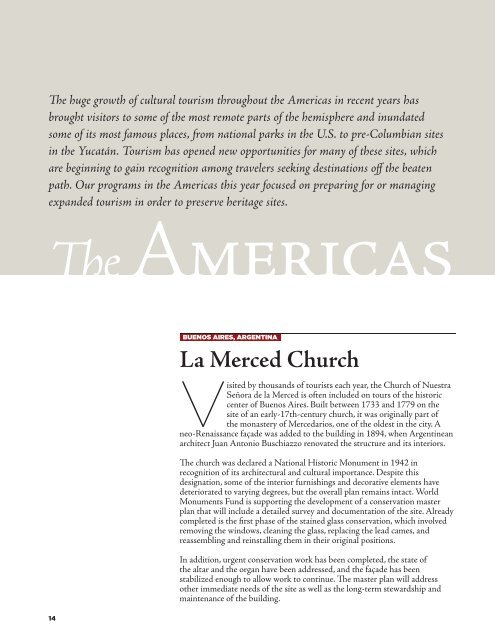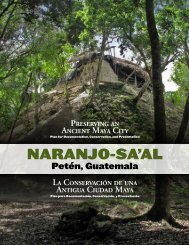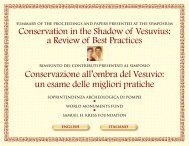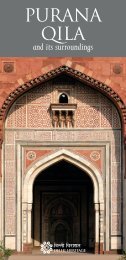2008 Annual Report - World Monuments Fund
2008 Annual Report - World Monuments Fund
2008 Annual Report - World Monuments Fund
Create successful ePaper yourself
Turn your PDF publications into a flip-book with our unique Google optimized e-Paper software.
The huge growth of cultural tourism throughout the Americas in recent years has<br />
brought visitors to some of the most remote parts of the hemisphere and inundated<br />
some of its most famous places, from national parks in the U.S. to pre-Columbian sites<br />
in the Yucatán. Tourism has opened new opportunities for many of these sites, which<br />
are beginning to gain recognition among travelers seeking destinations off the beaten<br />
path. Our programs in the Americas this year focused on preparing for or managing<br />
expanded tourism in order to preserve heritage sites.<br />
Americas<br />
The<br />
14<br />
BuEnos airEs, argEntina<br />
La Merced Church<br />
Visited by thousands of tourists each year, the Church of Nuestra<br />
Señora de la Merced is often included on tours of the historic<br />
center of Buenos Aires. Built between 1733 and 1779 on the<br />
site of an early-17th-century church, it was originally part of<br />
the monastery of Mercedarios, one of the oldest in the city. A<br />
neo-Renaissance façade was added to the building in 1894, when Argentinean<br />
architect Juan Antonio Buschiazzo renovated the structure and its interiors.<br />
The church was declared a National Historic Monument in 1942 in<br />
recognition of its architectural and cultural importance. Despite this<br />
designation, some of the interior furnishings and decorative elements have<br />
deteriorated to varying degrees, but the overall plan remains intact. <strong>World</strong><br />
<strong>Monuments</strong> <strong>Fund</strong> is supporting the development of a conservation master<br />
plan that will include a detailed survey and documentation of the site. Already<br />
completed is the first phase of the stained glass conservation, which involved<br />
removing the windows, cleaning the glass, replacing the lead cames, and<br />
reassembling and reinstalling them in their original positions.<br />
In addition, urgent conservation work has been completed, the state of<br />
the altar and the organ have been addressed, and the façade has been<br />
stabilized enough to allow work to continue. The master plan will address<br />
other immediate needs of the site as well as the long-term stewardship and<br />
maintenance of the building.
















